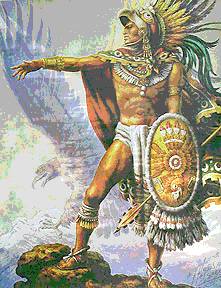WHI-Chap6/21-Obj9
Contents
Role of Social Classes in Aztec and Incan Societies
Aztec
Aztec society was very hierarchical, with the military elite at the top. All males were potential warriors, so even commoners could raise their status by distinguishing themselves on the battle field. The nobles were given careful instruction and training, so they had the most opportunities to display their talent on the battlefield.
Warriors

Accomplished warriors received land grants and tribute from the commoners. The most successful of the warriors formed a council that had administrative powers. The best foods and luxury items (vanilla and cacao) were reserved for them. Laws required commoners to wear coarse clothes while aristocrats were permitted to wear brightly colored cotton, lip plus, and eagle feathers.
Mexica Women
Women had no role in political affairs. Law subjected them to the authority of their fathers ad husbands. They are expected to stay home and remain occupied with motherhood and homemaking. Some were active in marketplaces and in embroidery and needle work. They had high honor as mothers of warriors; bearing children was as honorable as a warrior's capture of his enemy. Those who died in childbirth won the same fame as those who died on the battlefield.
Priests
The priests and the warriors made up the elite class. Priests received an education in reading the calendar and performing rituals. Because they took care of religious ceremonies that kept the word going and read omens, they had influence as advisers to the rulers. Some even became the supreme rulers of the Aztec society.
Cultivators and Slaves
Commoners live in community groups known as the calpulli, which shared resources, organized their own affairs, and allocated property to the families. In addition to this land, they also worked lands awarded to aristocrats and warriors and contributed labor for construction of palaces, temples, roads, and irrigation. They delivered periodic tribute that was distributed among the elites and stored in granaries.

Chinampa system
A large number of slaves, who usually worked as domestic servants, made up another class of people. They were mostly Mexica (because foreign war captives were usually sacrificed). Families sometimes sold younger members, and others were forced into slavery by criminal behavior.
Artisans and Merchants
Skilled artisans who worked with gold, silver, cotton, bird feathers, and other luxury goods enjoyed prestige. Merchants in long distance trade also acted as ambassadors and were sometimes under suspicion for being greedy. They supplied the elite with exotic products like gems, animal skins, and feathers. Warriors would frequently extort wealth and goods from unprotected merchants.
For more information on Aztecs:
Pages 541-548 in Traditions and Encounters
Founding of Tenochtitlan and Accomplishments/Characteristics of Aztec Empire
Aztec Religious Beliefs and Practices
How Aztecs Treated Conquered Peoples
Political and Economic Operation of Aztecs
Inca
Even though the Incans had a superior road network, there was no merchant/artisan class because the central administration supervised the long-distance exchange of agricultural products, textiles, pottery, jewelry, and craft goods. Some local bartering did take place. Many produced pottery, textiles, and tools for local use, and others produced finer goods for the elite classes.
Ruling Elites
The chief ruler was said to be a deity descended from the sun, which the ruling class venerated as the major god Inti. The "god-king" owned all land, livestock, and property and was absolute and infallible. Even after death, they were mummified and brought out during festivals, dressed in fine clothes, adorned with gold/silver, and offered food. Often, succeeding rulers would consult the mummies for advice.
Aristocrats and Priests
Aristocrats and priests led privileged lives: they ate fine foods and dressed in embroidered clothing provided by the commoners. Aristocrats had the right to wear ear spools that enlarged their ear lobes. Priests came from royal and aristocratic families. They were educated, celibate and ascetic and influenced society by conducting religious rituals. Major temples housed many priests, as well as their attendants and divine women that prepared meals and wove ritual garments. They listened to confessions and absolved people of their sins. In addition to aristocrats and priests, some sorcerers held high positions as well.

Inca Ear Plugs
Peasants
The cultivators lived in communities called the ayllu, which are similar to the Mexica calpulli. As units of rural society of various sizes, ayllus were groups of families that lived together and shared land, tools, animals, crops, and work. Peasants worked on lands allocated to them by the ayllu. If they were unable to pay the taxes, peasants worked state lands of the aristocrats and the production supported the ruling, aristocratic, and priestly classes. Granaries contained reserves for times of famine and for the widows, orphans, and other dependent individuals. The peasants owed compulsory labor services; men provided labor for construction of roads, buildings, and irrigation systems, and women manufactured textiles, pottery, and jewelry. Quipu helped bureaucrats keep track of this information.
For more information on Incas:
Pages 551-555 in Traditions and Encounters
Incan Religious Beliefs and Practices
Rise, Accomplishments, and Characteristics of the Inca People
How Incans Treated Conquered Peoples
Political and Economic Operation of Incans